
Diary of a Learning Management System
imc Learning Suite: Six pro tips to make your life easier when working with the LMS
Ever had words with your car? Yelled at the TV? Sworn out loud as you stab angrily at your PC keyboard? Or muttered “stupid system!” – only to discover, somewhat sheepishly, that the problem lay with you, not the system? It’s OK, we’re no different. Our consultants are intimately familiar with this phenomenon, too.
That’s why we talked to our consultants about the misconceptions and obstacles that most frequently cause LMS clients grief, and how they can be overcome. And sometimes it’s good to see things through the other person’s eyes, so we’ve decided to write this from the point of view of our learning management system and share some tips for a better handling of the LMS. That’s right, you may not be aware of it, but our LMS has feelings too, and it’s only trying to help!
The following excerpt from the diary of our learning plattforn is a light-hearted take on human-system interaction, but it contains genuine and practicable expert advice that will hopefully make working life less stressful and more relaxed for all concerned – you, the system, and our consultants.

Dear Diary,
8 a.m.: Dealing with a sudden mass influx of visitors
This morning, I wasn’t even fully awake and was hoping for a slow start to my day, but then I received another error message from China. It was from that important guest who checked in recently. Humans, by the way, always call guests “clients”, but “guests” sounds so much nicer to me.
Anyway, this super-important guest thinks it’s okay to check in an additional 50,000 learners without first telling us and giving my human colleagues – imc’s consultants and architecture experts – a chance to make the necessary server preparations. These preparations are quick to implement, but they’re not instantaneous. I mean, have you ever tried to find room for 50,000 guests who show up on your doorstep unannounced? We pride ourselves on being great hosts, and part of being a great host is being prepared.
Pro tip 1:
If you know you are going to need a large volume of additional licences, please give the consultants in charge seven to ten days’ advance notice.
Note: This does not apply to completely new clients or enterprise groups. In these cases, the preparations take an average of three months, as the process is a lot more involved.
12:15 p.m.: Bugs vs. user errors: Banishing misconceptions
My personal coach, Lia, always says I need to work on my stress management – it was her recommendation to keep a diary. I like Lia. She listens and helps me manage my endearing little peculiarities – the things that humans for some reason call bugs.
Bugs! Such an unkind word to use, given that everyone has their little quirks and tics. And to be perfectly honest, many of so-called bugs are not actually my fault, they’re user errors. There is always potential for user error, which is why my human colleagues and experts – wonderful people like Andreas and Christian – are there to help. They are excellent human-machine interpreters and are only too happy to clear up these sorts of little misunderstandings and misconceptions.
Pro tip2, for system administrators
Please do the user training sessions with our consultants and refer to the relevant training documentation. It will save a lot of time, boost productivity and reduce stress. That’s a promise!
1:00 p.m.: How gamification boosts motivation and enhances learning outcomes
It’s so pleasing to see that my new functions are being accepted and used by more and more guests. And to think that only a couple of years ago, they still had to log in separately to every system I’m connected to. Such a chore and a bore! But now, thanks to single sign-on authentication, it’s all so much simpler, and they can now access the entire learning ecosystem with a single click.
A lot has happened on the gamification front too. Being able to collect badges after completing courses is extremely motivating and makes learning much more fun. Up until quite recently, gamification tended to be frowned upon, especially in the more staid German companies. They’re supposed to be learning, not playing! Well, I disagree, because I can combine learning and play.
Successful learning comes from motivation, which is why I wholeheartedly recommend my skill management feature. With skill management, I can facilitate employee development by highlighting the skills employees already possess, and those they are yet to acquire.
The employer can then compare this information with the skill requirements in job profiles to identify which candidates still need development in specific areas, and which ones are suitable for the role because they already have the required skill set. This can be applied to all selection scenarios, from promotions to filling vacancies. I firmly believe that not using this feature is a wasted opportunity, particularly for guests who have a lot of office-based employees.
Pro tip 3
Don’t be afraid to move with the times! E-learning is so yesterday. Today, it’s all about creating unique learning experiences. Whether it’s small hacks, the use of gamification, or skill management, your employees will not only love it, they will become more productive.

3:30 p.m.: Using Netflix-like features to create unique learning experiences
Time for a coffee break, time to share a little secret: I will soon be getting some amazing new functions. And the best thing about it is that people are comparing me with Netflix – finally, a function that’s instantly recognizable for every user! Very clever of my developers to have come up with this: my new ability to recognize when different items of learning content deal with related topics. I can now recommend new courses or learning videos based on these similarities.
I can’t wait to see how this function is received once the first guests start trying it out. Who ever said learning systems are unsexy?
Pro tip 4
You should definitely check out the new channel function. Channels not only look great, they transform learning into a real experience.
3:45 p.m.: Courses and learning paths made easy
That’s my caffeine fix sorted. Time to move on to the next real challenge – in the form of a new guest from Australia. This guest creates three new courses, then complains that there’s no easy overview of who has done the courses or completed the tests.
But that’s another major misconception, unfortunately, because the solution he needs is already there: learning paths. Let me explain. First of all, there’s learning content. That can be any kind of training, whether face-to-face or digital. If I combine multiple items of content, then that’s a course. I can then combine multiple courses to create a learning path. If I want to, I can then also define various course prerequisites.
The idea of prerequisites is that the learner can’t progress to a higher-level course until they have passed the courses below it. You can even create placeholders – course templates – for individual courses in the learning path if, say, the course dates have not yet been finalized. Guests can then book the relevant courses in the learning path once the dates have been finalized, and the courses created. With this set-up, the administrator will always have total transparency regarding how far along the learning path the individual learners are, and can see full details of the courses.
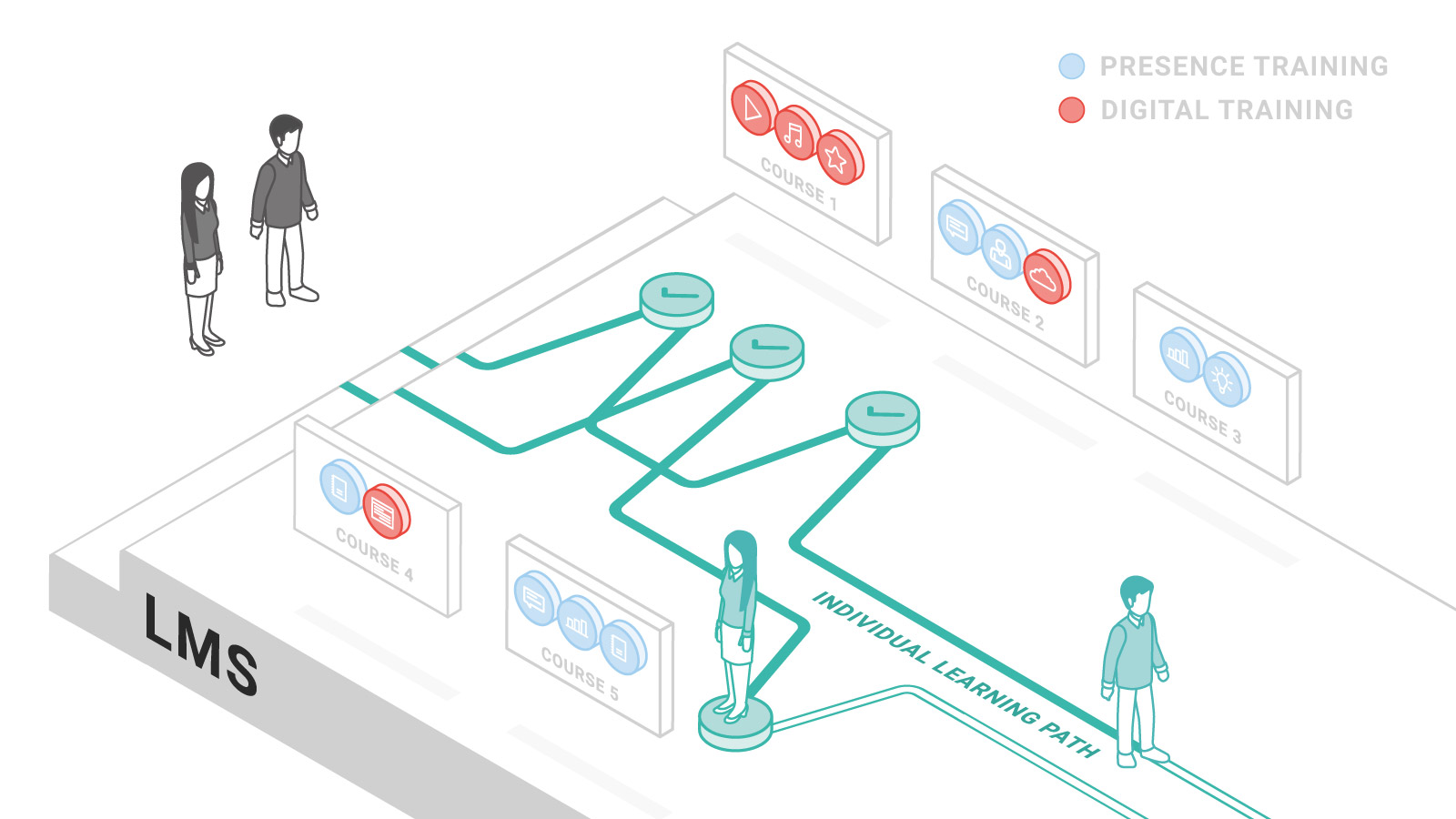
Pro tip 5
Learning paths need to be well thought out because they are intended for longer-term development programmes. In that sense, they are like semester schedules at universities. The latter comprise various lectures or courses, and by the end of the semester, students need to have attended all the lectures in order to pass.
So, it’s important to think carefully in advance about the purpose for which an item of learning content, a course or learning path is being created. Once you have created a learning path, it’s not that easy to make changes. If you are unsure, it’s best to double check with our consultants.
5:00 p.m.: Smart decisions with learning analytics
What a day! But the end is in sight. Meanwhile, there’s something I really want to get off my chest: I’m a precision system, and I can show humans exactly what they want to – or are allowed to – see, but only if they correctly specify what they want via my user interface.
The same principle also applies to authorisations. It makes total sense that sales consultants who only sell, say, drilling machines should not need access to user guides for gardening tools. But to give effect to that, you actually need to specify it in the roles and rights concept. That way, the group defined as “sales consultants for drilling machines” will only be able to view user manuals for drilling machines.
Also, my creators are constantly talking about learning analytics and how it can be used to create really cool dashboards. That’s another new functionality that I’m very proud of. Learning analytics enables you to “measure the business outcome of the learning process,” as my big boss and Head of Product Management here at imc, Wolfram Jost, would say. In other words, learning analytics lets humans track whether they are getting a good return on their investment in learning. Definitely a key technology to keep an eye on!
Pro tip 6
To get the right answers, you have to ask the right questions, so, if you would like to make purposeful use of learning analytics, it’s worth talking to a data expert or asking our consultants about targeted training courses.
6:00 p.m.: Performance review and new developments on the horizon
Well, it’s nearly time to finish up for the day, and I’ve got a really nice evening planned. The product management team will be coming by shortly, and I’ll be paying really close attention to what they say, because it’s about my future. I love my product managers because they’re always checking me over closely to spot untapped potential and find ways of making me even better than my competitors. Time to grab some data snacks, sit back and relax. I can’t wait to find out what updates they’ve got in mind for me.
Ok, Diary, talk to you again tomorrow!

Learning Ecosytem: A universe of Learning
If you want to use a learning ecosystem successfully in corporate learning, the technical requirements must be right. Time to shed light on what systems have to fulfil in order to be able to meaningfully map a genuine learning ecosystem.

The Ultimate eLearning Jargon Glossary
LMS, LXP, SCORM, WBT, EPSS, NGLE, CBT, ITS!? Lost in a world of elearning terms and abbreviations? No worries, we can help. In this A to Z, we shed some light on the subject and have compiled a list of the most important terms and abbreviations in the field of e-learning in 2022.
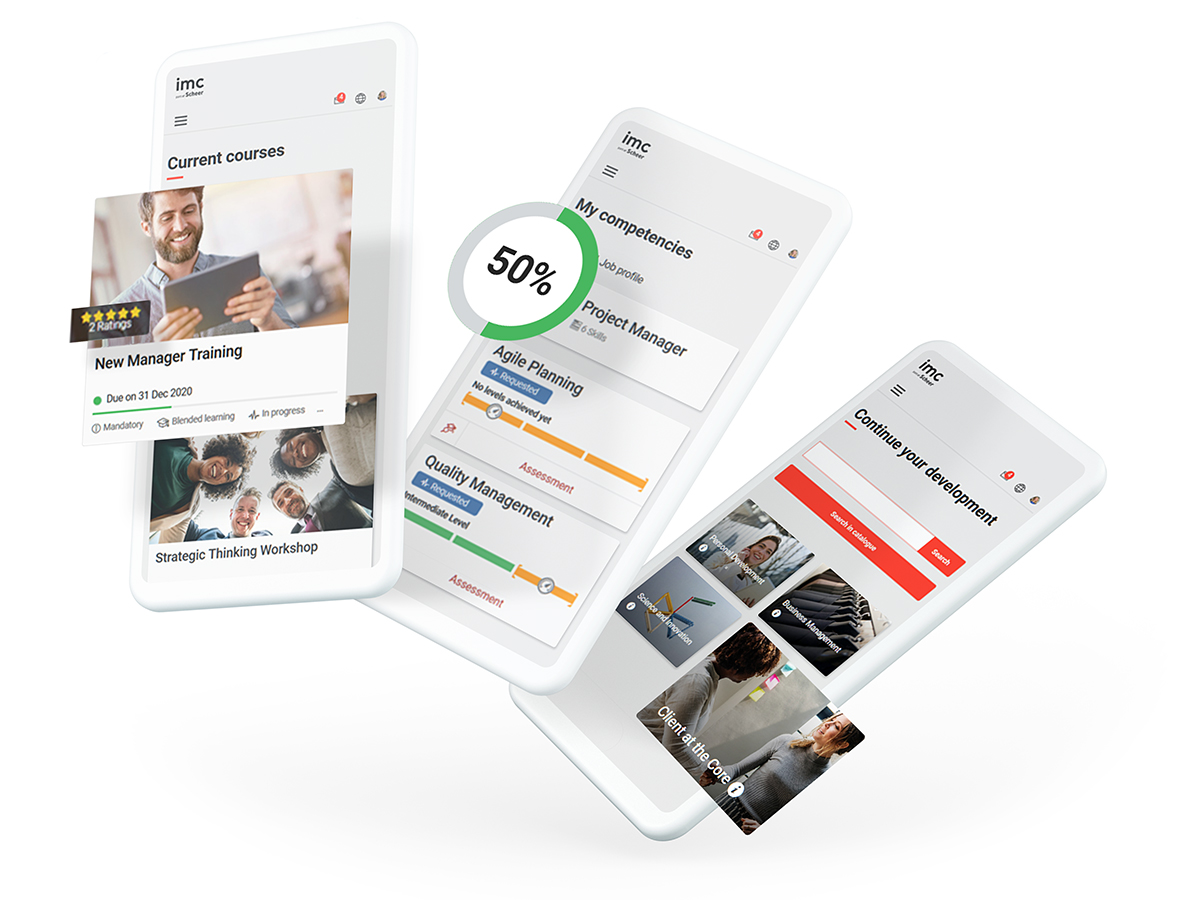
More about our LMS
If you would like to learn more about imc's Learning Management, check here for more information.

Contact person
I have been working in the Marketing & Communication Team at imc since March 2019.
Communication, creative content and social media are my passion. "KISS - Keep it short and simple" is my credo.
To explain complex content in an understandable way and thus make the topic of e-Learning accessible to everyone is an exciting challenge every day.
Privately I love to read, play poker and travel a lot.
I am always happy to receive feedback or suggestions.

Tips for Using 2D Maps in e-learning
The many advantages of putting learning content into a map structure
Learning content should be inspiring, if not utterly captivating. Ideally, it should be branded and look cool. And it needs to be engaging for the video gamer generation, without alienating more conventional learners. That’s a lot of boxes for modern learning experiences to tick.
Consequently, many companies and organisations are turning to map-based training. Even so, it’s a fairly new area, and the e-learning applications of maps may not be immediately obvious, despite the ubiquity of Google Maps.
That’s why we have put together this article. It explains the difference between 2D and 3D maps and illustrates the structure and advantages of 2D map-based training.

Differences between 2D and 3D maps
Arguably the most important difference between 2D and 3D maps is the browser performance required. 3D maps are rendered live in the browser, so they require more computing power and a very stable network or internet connection. The upside is that 3D maps allow dynamic perspectives: users can switch perspectives within the map.
A 2D map does not allow dynamic perspectives, but the viewer can create the impression of changing perspective by moving relative to the map. This 2D principle is employed in many strategy games, for example. The map is based on images in which it is not possible to change perspectives. The advantage is that fairly large story/learning worlds can be shown without requiring a lot of browser performance.

2D animation
2D does not necessarily mean static. Within a 2D world, it is possible to have individual elements that are animated and dynamic. This is called 2D animation, and it lends life and vibrancy to 2D maps. It is even possible to integrate 3D graphics into 2D maps.
The introduction: arriving on the map
As with most learning experiences, it’s a good idea to start with an introduction. The introduction can appear or pop up on the map in the form of a chat window or a specially created page that briefly outlines the storyline and subject matter of the training session. It is advantageous here to explicitly tell the learner what the training task will involve, and what their objectives are. The benefit of showing an introduction directly on the map at the outset is that the learner does not need to leave the learning world and therefore does not lose focus.

2D Map Training Deutsche Bahn
The main narrative: read the map
It is vital that the main part of the session is self-explanatory. This means the map must be intuitive to use. A certain degree of in-map guidance can be achieved by unlocking individual tasks step by step. That way, learners intuitively know the correct task order, without having to be explicitly told. Crucially, this approach allows learners to discover the learning content for themselves, i.e., exploratively. The navigation leads via the 2D map to various locations that the learner can ‘visit’. An example would be where the map shows a building that the learner can click on and enter in order to progress to the next task or access a learning nugget.

2D Map-Training Deutsche Bahn
Interstitial and achievement screens can be used to lend further structure to the main narrative by appearing as pop-ups overlaying the map. They can provide orientation by showing learners their next tasks, highlighting their progress, or making them aware of further options. The whole learning experience can be made even clearer by adding jump labels to individual locations on the map. These can be used to help the learner navigate from tasks to their associated learning content.
GOOD TO KNOW
Learners should not need to leave the map (the learning world) at any point. Everything they need in order to achieve their objectives should be contained within the map. This can be achieved, for example, by using chat windows that open directly on the map, or by showing learning nuggets, content items and hints as overlays on the map.
The conclusion: leave the map
In 2D maps, just as in other learning settings, it is important to clearly mark the conclusion of learning units and tasks so that learners know they have successfully completed the section in question or indeed the entire training session. There are many different ways of doing this. The key is to ensure the method chosen fits with the training session’s overall storyline. For example, you can use a list of checkpoints which is then displayed at the end with all tasks checked off. Or you can show a notification in the chat window.

Success message at the end of a training session
Questions?
Can a map-based training session also be short?
To retain the map’s explorative dimension while at the same time creating a training session that can be completed within a short space of time, you can reduce the amount of learning content, streamline the user experience, or confine exploration strictly to key locations on the map. The main thing is to maintain excitement while keeping the learning purposeful.
How gamified can a map-based training session be?
The primary focus must be on the learner experience, so the map should not contain any unnecessary actions or locations.
Surely map-based training sessions are very labour-intensive to produce?
Not necessarily. The total overhead can actually be relatively low, as the world created by a 2D map makes a relatively large contribution to creating an exciting learning experience. It is possible to reduce the design overhead that goes into learning nuggets/subpages by integrating them into a 2D map.
But isn’t that really expensive?
The 2D map format does not necessarily require more design work by our experts, so it is a very good alternative to 3D maps, even for limited budgets.
What are the other advantages over 3D maps?
Good performance, low overhead, faster page loading.

Rapid Content Development
We want things now: fast food, coffee to go, messenger services, online shopping … we no longer have time. Companies have also clocked onto this trend, and want to stay up to date with their training courses.

Gamification takes corporate learning to a new level
The fact that Game Based Learning works as a motivational booster for e-learning is already rooted in childhood. We have summarized the most common types of games and practical examples for you.
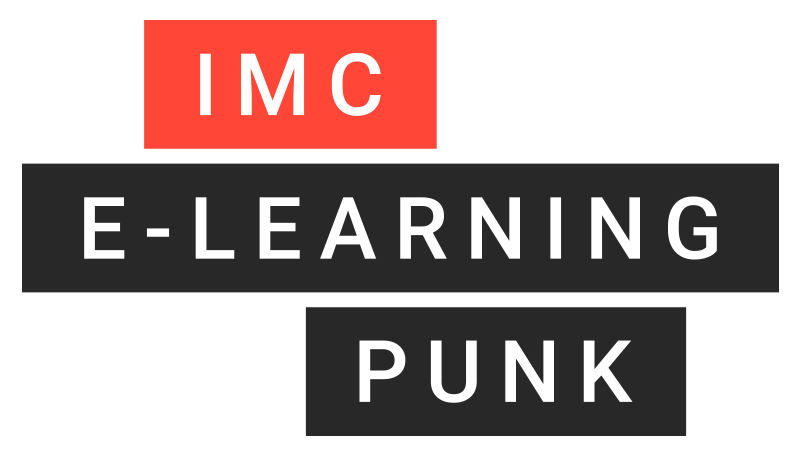
Contact person
I joined the imc newsroom team in 2021. As a journalist my heart beats for content and storytelling.
I’m excited to figure out how e-learing and digitization affect the future of work. My task is to create content to talk about and I’m always looking for trends.
Privately I love to travel and eat Tapas.
Topics: E-Learning Trends, Corporate Social Responsibility, Press and Influencer Relations

How to Increase Channel Sales Revenue with Extended Enterprise Learning
Here we look at how to increase channel sales revenue with extended enterprise learning, whether that’s via franchisees, resellers / affiliates, distributors or even your existing customers.
If your company has a sales team, it’s common to focus your efforts as a manager on equipping your employees with the strategy, knowledge/skills and assets they need to maximise new business. However, few companies operate in isolation and there is often an extensive network of partners that could work better to help you sell more of your products or services.
That network potential is known as the Extended Enterprise....

What is Extended Enterprise?
Extended Enterprise is a term coined by Chrysler in the 1990s to describe the collaboration between a company and its supply chain to gain competitive advantage. Since then, it has broadened to encompass a company’s entire network of collaborative relationships from suppliers to logistics, retail partners and end-users or customers.
Paying attention to the entire extended enterprise (sometimes referred to as the ‘Value Chain’) allows managers to see opportunities to improve efficiency, elevate sales and maximise profits.
The concept can be applied to any 3rd parties who can directly influence the success of a business. So, by fostering more collaboration at all levels outside your own company, potential partners can be leveraged beyond them just performing their main role (i.e. doing the bare minimum).
Ways to Increase Channel Sales Performance
Here are 5 ways to increase channel sales performance that can be adopted by any marketing or business development manager with a network of partners:
1. Measure performance frequently, and from the outset
Before diving straight into a new programme of activities to boost revenue, it’s important to measure existing performance so that you can see what partners and tactics are seeing progress over time.
Establish your current baseline, then track changes consistently so that you can see patterns across activity and new business generated.
Sharing performance data with your channel partners will build trust as it will show you are invested in their performance, and will help both you and them to see what is working.
2. Incentivise channel partners
Your internal sales team is likely compensated based on business development performance. However, suppliers and logistics providers may be doing business with potential new customers. Give them a strong reason to think of recommending you - don’t limit revenue incentives to traditional sales channels, such as retailers.
3. Provide assets that communicate your brand and sales messages
Sales teams are always provided with marketing materials that communicate the latest messaging to reinforce your unique selling points and branding. However, external partners are not always given the same benefits.
By viewing every member of the extended enterprise as part of your team and as a potential salesperson, you’ll naturally think to give them all the latest materials and insights.
In the world of web hosting for example, affiliate schemes are extremely common. Website hosts often provide affiliates with a login area containing a knowledge hub of sales advice and a wide range of adverts for use on an affiliate’s own website.
4. Create bite-size learning content
If it’s your own sales team, it’s their job to study and absorb your new, 50-page product brochure. If it’s your logistics provider - they’ve got their day job to focus on and an in-depth manual will be too daunting.
Be selective and give them some bite-size learning materials that will allow them to further their knowledge of your products and services to the level where they can be a good advocate for your company.
5. Communicate proactively
Don’t just hand over new learning materials and expect the new business to start rolling in. Check-in regularly with all aspects of your extended enterprise and make sales performance a key part of the discussion. Not only will it show partners that you are serious about their sales potential, but you’ll learn about what aspects of your extended enterprise learning content is working for them. Maybe affiliates love it, but suppliers find it cumbersome. Listen, learn, tweak and repeat.
So, if you think following the 5 principles above might work for your company and your existing or potential channel sales partners, how do you make communicating and sharing knowledge and assets with them easy? That’s where an extended enterprise learning platform comes in.
Extended Enterprise Learning Platforms
The extended enterprise learning platform creates an environment for sharing knowledge and best practice, and making the latest materials available for your channel sales network wherever and whenever they need it.
Also known as an Extended Enterprise LMS (learning management system), this platform should make it easy to add or update partner training materials with little to no duplication of effort across different internal or external user groups.
Here are some of the key features of the best extended enterprise learning platforms:
Whoever creates and distributes your knowledge and sales materials for your internal and external audiences should be able to do so via a single user area.
A multi-tenancy LMS enables you to create different user experiences for different types of external partner, such as suppliers, franchisees or distributors without being distracted by irrelevant training pathways or materials. You can even create a unique ‘tenant’ area that is set up with your partner’s branding (or co-branding with theirs and yours) to make them feel at home.
Rather than handing over some learning materials and leaving partners to get on with it, you can really increase channel sales revenue by offering ongoing support and, if appropriate, allowing a level of interaction across user types. This can lead to knowledge-sharing that breeds new ideas, collaboration and synergies.
You don’t want an extended enterprise learning platform to be yet another piece of software to get to grips with and that adds another layer of logins and admin duplication. A good extended enterprise learning platform will integrate seamlessly with your existing IT systems.
While ensuring data security, system integration will allow user data sharing with HR system for internal staff and your CRM for channel sales partners for example. Single sign-on (SSO) eliminates the hassle of logging in and out of various systems with various passwords.
If you’re rolling out an extended enterprise learning platform to help boost channel sales revenue, you’ll want data on how it’s affecting performance across each part of your partner network. A good platform will give you reporting and analytics tools that give you actionable insights across geographies and partner types.
Find which content is not getting looked at to understand what is not engaging partners. See which partners are driving the most new business and align that with their use of learning and sales materials to then use them as the benchmark for best practice.
This information will help you to turn extended enterprise learning into a machine for driving new business via channel sales - whether that’s from existing partners and distributors or leveraging the potential of your supply chain.
Whoever creates and distributes your knowledge and sales materials for your internal and external audiences should be able to do so via a single user area.
Can we help you to increase channel sales revenue with an extended enterprise learning platform?
Get in touch with us here at imc Learning for an informal discussion about your needs and performance goals.

Turning a learning curve into an earning curve
Set online training up for success in such an extended enterprise learning scenario, and how to turn a learning curve into an earning curve.

Learning Management System for Membership Organisations
Make your platform effective for current and future training needs for your membership organisation.
Learning culture nourishes learning ecosystems
Why learning ecosystems need more time and room
When employees are looking for suitable learning resources, they can often choose from a wide range of contents and formats. This can often make finding learning content that meets the specific requirements time-consuming and inefficient.
Technology can solve this issue. A learning ecosystem links several learning platforms and presents the formats and contents clearly in the learning portal.
Many organisations already utilise learning ecosystems, especially larger companies. A learning management system (LMS) often serves as the foundation. This becomes an ecosystem with the integration of additional platforms and tools, such that both internal and external sources feed into search results.
But what good does a solution based on the most advanced technology do, if it is not well received by the learners? User acceptance relies on a corporate or organisational learning culture that is fit for the future.

“In future, personal and professional development will go hand in hand”
It is not the addition of content that makes a learning ecosystem grow, but its expansion through tools and systems. Fundamentally, that means opening up the LMS and integrating external platforms with external content to create a basis for the development of an ecosystem. Yet, that takes courage!
What happens when companies take the leap and hand over control of their learning system? “Responsibility is transferred to the employees,” says Sven R. Becker, Member of the imc Executive Board. “Thus far, the senior management typically dictates corporate learning, which gives it a regulatory character. Yet, experience shows that the company’s success depends on how much learners are involved. A learning culture transformation has to start with the workforce and grow from there. That requires a mindset shift but should be the clear goal.”

Customised learning paths can be a solution when implementing this, as they help to address personal requirements in a more targeted manner: “In future, personal and professional development will go hand in hand. Different learning systems and achievements must be recorded and stored automatically,” says Andreas Pohl, Director Research and Development at imc. “That facilitates the creation of tailored, custom learner profiles which enable learning across the boundaries of a specific organisation.”
Acceptance and motivation are the first step
“No appointments today – I’m learning.” Is it possible to write that without earning funny looks? Making it possible is a key task for modern companies. Learning and professional development must lose the “necessary evil” or “seminar as a benefit” labels and be anchored as a vital component of corporate culture. One option is to specify professional

Good content can boost the motivation to actually use a learning ecosystem. Sven R. Becker explains: “One trend that is clearly set to stay is gamification. Yet, that alone is no longer enough to win over the new generation of talents. Engaging activities and formats are needed. Getting the mix right is important. A good, blended learning experience is marked by variety – it offers something different. Great stories are remembered and motivate the learner to continue.”
Employees need time and room for creativity to leverage a learning ecosystem
Companies like Microsoft already utilise learning days, learning time, and learning sabbaticals – with great effect. Similarly, the appointment of learning ambassadors has proven successful for several customers of ours. In the automotive sector, some companies have transformation guides who are trusted by their colleagues, putting them in a position to help create awareness for professional development.

Sven R. Becker firmly believes that the strongest ambassador for any measure is the person most critical of it: “If you succeed in changing the view of the strongest opponent, you gain the greatest multiplicator in the company.” Several imc customers have achieved great successes with the learning ambassador model, says Becker.
Learning that is independent of location and time constraints also makes it easier to access the system. That is why it should be equally available from mobile devices and from the workplace.
User generated content – Quick and easy, from creation to publication
An ecosystem keeps growing continuously. Authoring tools are a great option for adding content and knowledge straight from the in-house expertise, as they allow any user to share their know-how.
This turns the learner into a purveyor of knowledge. In that role, they assume responsibility within the system – which will also boost their own motivation.

The technology already provides for this. All that is left to do is to get the learners’ buy in. While that may seem like a monumental task, these initial key steps will get your company on the right track:
- Take the leap and expand your learning ecosystem
- Create acceptance for professional development
- Create a great learning experience with motivating content
- Offer time for learning
- Enable employees to help shape the learning experience
- Not trying is the biggest mistake you can make!

Learning Ecosystems: A Universe of Learning
If you want to use a learning ecosystem successfully in corporate learning, the technical requirements must be right. Time to shed light on what systems have to fulfil in order to be able to meaningfully map a genuine learning ecosystem.

Future of Work: Interview with Çiğdem Uzunoğlu
Competence transfer thanks to digital games? It's possible! In an interview with Çiğdem Uzunoğlu, we explain how computer games and continuing education fit together and how they can be used effectively.

Contact person
I joined the imc newsroom team in 2021. As a journalist my heart beats for content and storytelling.
I’m excited to figure out how e-learing and digitization affect the future of work.
My task is to create content to talk about and I’m always looking for trends.
Privately I love to travel and eat Tapas.
Topics: E-Learning Trends, Corporate Social Responsibility, Press and Influencer Relations, New Work

Learning ecosystem: A universe of Learning – why you need it, how you build it
Discovering new worlds of corporate learning
The L&D sector has largely reached a consensus: Customisation must play a bigger role in corporate learning. We must strive to democratise knowledge. The panacea needed to achieve these ambitious goals? A learning ecosystem. The focus is almost exclusively on soft factors related to the corporate and learning culture when establishing such a system, neglecting technological aspects.
Yet, suitable software such as a learning management system or learning experience portal is vital. Let’s take a step back to grasp what a system needs to achieve to map a meaningful learning ecosystem.
Inflexible systems and uniform learning paths for all employees are a thing of the past. Nowadays, companies face the challenge of creating a learning ecosystem that promotes self-directed corporate learning in the long term.
Such a system links various platforms and creates a clear structure for the different formats within a learning portal. The search function leverages all integrated systems, taking account of both internal and external sources.

Andreas Pohl, Director Research & Development at imc
So much to the theory. The question now is: What technical structure enables a learning ecosystem to meet all requirements and offer real benefits to the employees?
What role does a learning management system (LMS) or learning experience portal (LXP) play within such learning universe?
imc expert Andreas Pohl, Director Research & Development, leads the development of such systems. Thanks to his many years of experience, he is very aware of the hidden potential learning ecosystems offer.

Hello Andreas! What would a learning ecosystem look like in practice? Can you give us a specific example?
Let’s say we have an industrial client who manufactures special parts for large-scale equipment. All new employees and trainees must know how to use the equipment employed to make these parts.
They train on a training machine to learn the workflow. Now, it is possible to link this training machine to a learning management system (LMS). In that case, a new employee could log into the training machine with their personal identifier. Once they have mastered the workflow, the machine automatically transmits the training success to the LMS where the training is marked as complete.
This is then booked in the employee’s learning path or as learning progress – for instance, as part of their on-the-job training. Thus, the communication between the different systems makes learning easier. This example might be a little staged, but I think it illustrated the practical application of a learning ecosystem very well.
What does a learning ecosystem need to do to make learners use them?
Before you start thinking about a learning ecosystem, a suitable cultural framework must be in place.
As an employer, I need to motivate employees to use a system and allocate time for that purpose. At the same time, the user experience of the learning ecosystem (LE) must be structured in such a way that the employees enjoy using it, and make it easy for them to find relevant content.
A user will be far more likely to use the system when they can see an immediate and direct benefit. If that benefit is not obvious, you have lost.
How do you realise that from a technical perspective?
There are two approaches: First of all, I can make the LMS or LXP the central hub for my learning ecosystem. In this case, the LMS also needs to be able to present contents from external sources.
The learner can find materials from the entirety of the ecosystem through the frontend of the LMS. It makes no difference to them where learning content is stored – in the company LMS or, for instance, an integrated content library. For the learners, it is important that the system is easy to navigate and that they can quickly find relevant contents without jumping through hoops. Whether or not this takes them into a different system is irrelevant.
The second approach is to subordinate the LMS to the overarching portal. Rather than being at the centre itself, it delivers its results to the top level. This is useful when a central portal already exists and the LMS is integrated at a later stage.
How does an LMS become part of a learning ecosystem? What are the prerequisites?
In the second case – when the LMS is a cog in the wheel – the contents must be supplied to the overarching system. Indexing then becomes a major factor. That means that content must be provided in a format that triggers useful search hits presented and shown in a meaningful manner. The same applies to recommendations the system gives the user based on learning habits or interests.
Good APIs (application programming interfaces) are the key success factor for these types of functions. They facilitate the communication between the different applications. Effective and standardised interfaces are always important in IT, but whenever several systems come together, they become absolutely crucial.

How does an increase in content affect the individual interfaces and components?
This is a very interesting question. Let’s break it up into two parts. To illustrate: Your universe might grow because the number of planets is increasing, or because the existing planets are becoming more populated. These are two very different scenarios.
Similarly, you can expand your learning ecosystem by integrating or linking new components, or by adding more content to the existing elements.
After all, the purpose of a learning ecosystem is to continuously and frequently change the volume of the learning content, and the integration of user-generated content (UGC). Going back to our analogy, user-generated content merely increases population density on a given planet. From a technical perspective, this is not a critical process, as the growth takes place within an existing system with no effect on the complexity of that system. It would therefore not qualify as a true expansion.
So, what is “true” expansion? What do we have to watch out for?
I would say a true expansion of the ecosystem involves the integration of additional systems or a new interface. This expansion process is somewhat slower, as each new system needs new interfaces or gateways.
Each “planet” needs to provide the information within the LMS to the other “planets” – and ultimately the user – through standardised interfaces, and various APIs as well as an event bus are utilised for this purpose. Meanwhile, the central system must be able to absorb content and integrate it in its search function to make it accessible to its users.

How does the system know which content should be shown?
The system can only show content it knows. That means either the index content must be transmitted to the system – for example, via a data or event bus – or the system must have direct access to the index. Naturally, this can only work if indices are properly maintained and clearly structured.
What role does the data or event bus play?
An event bus is basically a messaging system. One system throws a message onto the bus, the bus takes off, and the next system can retrieve the message.
The message does not disappear after it is retrieved by one system – it remains available for the other systems. For example, systems A, B and C “take” the message, but system D ignores it, because it’s not relevant to it. Meanwhile, system D might “take” a different message that A, B and C are not interested in. Messages are thus distributed in real time, making manual message transfer to each system redundant (publisher-subscriber approach).
The challenge with this approach is that each system involved must be able to understand the message contents. This often requires some adjustments, as some systems might not be able to translate it directly. This is a major current topic for our development team.
What trends would you say can make learning ecosystems even better?
There is certainly room for improvement in system alignment, which also encompasses IoT (internet of things) and ESB (enterprise service buses). In other words, systems need to know both, which message they need to retrieve from the bus and which immediate adjustments they need to make.
This reduces the need for system adjustment. Now, an ESB is not a trivial thing, and might be overkill for a straightforward set-up with a small number of systems. However, my learning ecosystem is fairly complex and serves more than 10,000 employees, it makes an enormous difference.
Another thing we are working on at the moment is switching over to external contents. Right now, we can integrate external content in the search through our LMS, for example, through the LinkedIn Learning Content Importer. We want to expand that capability to enable the user to switch directly into the external system. We are currently collaborating with a major client to achieve that.
Finally, what should we pay particular attention to? Where do you see the most potential? Are there also disadvantages?
It comes at a cost. None of this is free. Everything we talked about needs investment. The systems need to be maintained continuously, as do the connections to the interfaces, and some of these systems might be proprietary. It’s not an automated process.
Ideally, that will enable me to create a learning ecosystem which optimises how the different needs of all my learners are met. Everything then comes from a single source, which is a whole lot more user friendly and actually feels like one system. A good learning ecosystem goes a long way towards improving the learner experience and providing real support to employees in their daily work.
My advice: Good planning is half the battle! It is important to clarify from the outset what you want to achieve, how many systems should be maintained and how much maintenance can be provided.

How not to break bad with validated processes in an LMS
What requirements must an LMS map for validated processes? And how does Breaking Bad fit here? Questions about questions not only the Pharmaceutical industry should think about.

Learning Analytics: It comes down to the right questions
Learning must not be an end in itself, but fit in the company’s business outcome: More and more managers are demanding this. We therefore looked at how L&D managers can meet this requirement with the help of Learning Analytics.

More about our LMS
If you would like to learn more about imc's Learning Management System, check here for more information.
Contact person
I have been working in the Marketing & Communication Team at imc since March 2019.
Communication, creative content and social media are my passion. "KISS - Keep it short and simple" is my credo.
To explain complex content in an understandable way and thus make the topic of e-Learning accessible to everyone is an exciting challenge every day.
Privately I love to read, play poker and travel a lot.
I am always happy to receive feedback or suggestions.
Computer Games in Professional Development
“Games have helped to shape the development of AI applications”
Çiğdem Uzunoğlu has been Managing Director of the Foundation for Digital Games Culture since February 2018. In this interview, we asked the games expert, how computer games and professional development go together, and which competences can best be conveyed with digital games. We also wanted to know, which changes game fans can expect thanks to the enormous technological advancement relating to AI.


Hello Ms Uzunoğlu, thank you for making time for this interview on (serious) games. We are particularly excited to hear your answer to our first question. Do you have a favourite computer game?
Çiğdem Uzunoğlu: No, I have no absolute favourite game. One of the games I really enjoy playing right now is Supertype. It is both simple and fascinating. Players can train their physics skills and abstraction capability by solving small riddles.
That sounds entertaining but also demanding. The foundation you’re managing aims to highlight economic, cultural and social potentials of digital games as sophisticated as this one. A rather extensive and ambitious goal? What specifically is behind that mission?
Çiğdem Uzunoğlu: What is behind games? Groundbreaking content, design approaches and technologies for the digital age. Yet, these games components are barely developed for applications outside of the games industry. Our foundation wants to change that. We believe in a society that leverages games to shape digitisation, employs gamification to find new approaches to problem solving, and understands digital games as enrichment of its cultural identity. On that note, we consider ourselves a bridge between the games industry, society and other parts of the economy. We highlight opportunities for collaboration, and create new connections between players from different fields. That is why we also describe our work as a cross-over approach.
What would you say makes a computer game valuable?
Çiğdem Uzunoğlu: Games are cultural goods. In principle, every game has a certain underlying value. It is always a cultural product created by certain persons under certain circumstances. Commercial productions are primarily concerned with the games being fun, fascinating and engaging – the same criteria that mark successful books or movies. Of course, there are games that create awareness of relevant issues, or aim to convey specific content. That also applies to serious games. Yet, even an abstract game without a clear message can have artistic value.

"Commercial productions are primarily concerned with the games being fun, fascinating and engaging – the same criteria that mark successful books or movies. "
Do you think certain competences are best learned in a game rather than by other means?
Çiğdem Uzunoğlu: In general, games teach us to deal with frustration and failure. In the long term, you can only be successful if you are able to learn from your mistakes. Most games are based on some sort of system. This makes them particular suitable for getting across relationships. You learn to grasp the consequences of your actions. You understand how individual changes affect a bigger process. According to a recent study by PwC, HR managers who already use serious games utilise these primarily for training soft and hard skills, as well as their employees’ cognitive skills. Digital games are also used more intensively in training and professional development. The interactive aspect helps to convey complex learning material and solidify knowledge.
Where do you see possibilities and opportunities for companies for imparting competences with a game-based approach?
Çiğdem Uzunoğlu: For many people, games open the door to the digital world. So, when it comes to digital topics, gamification and serious games allow you to pick up from where their daily life begins. According to PwC, more than half of the HR managers using serious games see a clear benefit from these games. The same applies to colleagues and superiors who hold that the fun factor helps to understand and manage work processes. Everyone can progress at their own pace, which also removes any fear of real consequences. At the same time, results are easy to analyse and compare. That is why HR professionals see the greatest potential for serious games in the training process.
Can computer games challenge themselves? How can computer games sensitise for moderating the use of digital games?
Çiğdem Uzunoğlu: Games that question their own content have been around for a while. For instance, the German game “Spec Ops: The Line” deconstructs the image of the heroic soldier and the just war. Meanwhile, at the end of Metal Gear Solid 2, the protagonist faces the fact that their reality is only a simulation and that they should switch off their console. Apart from such content-related conflicts, there are also certain mechanisms that indicate that a game might have been played for too long: game characters getting tired or text overlays.
Let’s move on to the scientific topic of the year: artificial intelligence. AI has a major impact on digital formats and solutions. How do you see technology changing the gaming sector? What is your assessment of that technology in principle?
Çiğdem Uzunoğlu: Artificial intelligence has always played a crucial role in games. After all, we are competing against the computer unless we have a human opponent. Thus, the games industry has helped to shape the development of AI. Especially when extensive animated game worlds are produced, complex AI systems are working in the background which react to our interactions. Some games also allow us to build relationships with characters that are controlled by the computer. These relationships will change depending on our actions in the game. AI systems in the background make this possible.

Which AI-based serious games do you know? Where are these successfully utilised?
Çiğdem Uzunoğlu: For most games, AI is a key component of a bigger creation, just like graphic and audio design. Naturally, the same holds true for serious games. Digital games respond to our actions or inputs based on algorithms. These are AI systems, albeit weak ones. The main drivers for innovation are found in the large entertainment games segment. A while ago, “Middle-earth: Shadow of Mordor” based on The Lord of the Rings caused a great sensation. In this game, AI opponents learn from every battle and adjust to the players’ behaviour. You could say they “remember” past encounters.
What future trends do you see for AI-based computer games?
Çiğdem Uzunoğlu: Especially in the major international games productions, the trend goes towards the creation of even more realistic worlds inhabited by almost lifelike characters. Of course, if you want a character to appear more real and behave more intuitively to the player’s behaviour, you need more sophisticated AI systems. So ultimately, it is about leveraging AI to create virtual characters exhibiting plausible reactions to ourselves.

"So ultimately, it is about leveraging AI to create virtual characters exhibiting plausible reactions to ourselves."
Do you think there are limits to the use of AI in computer games? What would those limits be?
Çiğdem Uzunoğlu: Generally speaking, limits are dictated by the current state of the art and the budget. That is why continuous funding for games on a national level is crucial for the German games industry, especially with regard to the last aspect mentioned. German developer studios can only keep up with the international competition if they have sufficient financial means. That applies to AI specifically, but also to games production in general.
We are curious about your foundation’s upcoming projects. Which one are you most excited about?
Çiğdem Uzunoğlu: First of all, we initiated a new event series on cultural aspects of games this year as the next instalment of “Quartett der Spielekultur,” which is supported by the Federal Commissioner for Culture and the Media. We also launched GamesTalente, a nationwide sponsorship programme for teenagers, together with Bildung & Begabung (“education and talent”), the national centre for the advancement of young talent. In line with our objective to build bridges, we will guide representatives of various foundations and a group of educators through this year’s Gamescom trade fair, and introduce them to the particularities of the industry. Several other projects – some with national reach – with renowned partners like the Konrad Adenauer Foundation and the Foundation “Remembrance, Responsibility and Future” (EVZ Foundation) are in the application stage. Naturally, I am greatly anticipating feedback and responses to these.
Thank you very much for the exciting interview, Ms Uzunoğlu! We will keep a keen eye on your planned projects, and wish you every success with all your ambitions!

Career development rethought: training soft skills through serious games
Communication and leadership skills are more important than ever, not only in times of virtual teamwork. We show you how you can map learning progress in a meaningful way and give you a summary and an outlook on future developments.

Gamification raises corporate learning to a new level
Many large organisations are already taking advantage of the positive effect of games on learners when it comes to the professional development of their employees. We have taken a closer look at the most common types of games for you.

Contact person
I joined the imc newsroom team in 2021. As a journalist my heart beats for content and storytelling.
I’m excited to figure out how e-learing and digitization affect the future of work.
My task is to create content to talk about and I’m always looking for trends.
Privately I love to travel and eat Tapas.
Topics: E-Learning Trends, Corporate Social Responsibility, Press and Influencer Relations, New Work

The Ultimate Benefits of an LMS and an LXP Integration
Combining the best of two worlds: Why LMS and LXP will merge into integrated platforms

There is a massive but fragmented market for training and learning tools in this new decade, with more than 30 Learning Experience Portal (LXP) vendors, 200 LMS vendors, and thousands more who specialise in creating various tools.
Collaboration, content development, analytics and mobile learning are the main purposes of these tools [Source: Josh Bersin Academy]. Moreover, these vendors are beginning to take note of a trend towards integrated platforms to benefits companies.

LXP: The new kind of product?
An LXP’s purpose is to improve self-directed learning and give learners control over their decision making in their own learning. However, it doesn't acknowledge the importance of the organisation and its corporate goals.
Josh Bersin defined the term “Learning Experience Portal” several years ago as a new type of product. In this portal, the learners understand the objective of their learning “in a workflow" defined by them.
However, why should we consider a new category when the term Learning Management System (LMS) subsumes all forms of teaching and learning? We must remember that LMS were originally designed to enable the “management” of learning only. They concentrate on:
- Business processes,
- Control of learning processes (such as adherence to compliance requirements),
- The provision of catalogues, and
- The corresponding evaluation options for an organisation.
Learner engagement, adaptive learning and AI
On the other hand, engaging learners is an LXP's objective. The LXP is partly mapped with self-directed learning through the integration of competence-based methods. If the target group is homogeneous, then we can apply the principle of LXP more successfully.
In the past, Learning Management Systems did not consider self-directed learning in its features. However, this is changing rapidly and learning systems are catching up. This is due to the increasing decoupling of front ends and back ends via corresponding API functionalities. Moreover, innovation cycles are becoming ever faster and interfaces can be individually adapted for each learner group. Eventually, they offer an individual user experience when required.
Additionally, artificial intelligence has become an integral part of almost every solution. This means that topics such as adaptive learning, content curation and personalisation can be found in both worlds. An LMS has all the necessary learning processes that an LXP does not, including regulatory training and on-the-job functionalities. This means that courses and learning processes can be mapped in an integrative interface.
Integrated learning platforms are here to stay
Learning systems must integrate more and more into existing infrastructures. This means that they can also partly give up their own core functionalities. In addition, the latest trend is the integration of different portals with an individual user and learning journeys for different target groups, such as internal employees and external partners. This helps to create the best possible user experience.
Since learning experience portals focus more on the experience aspect, it is becoming more difficult to offer target groups or case-orientated portals.
This is where an LMS has an advantage due to its technological structure. Front ends have traditionally been developed for their back ends to be connected via APIs (e.g. REST API). This provides these learning systems with a powerful tool for integration and interoperability.
Almost by chance, we can set up entire learning ecosystems by developing stable and extensive API management. If we spin this a little further, an Internet-enabled refrigerator today can provide learning content of a product at breakfast.
But LMS and LXP integrations are not only used to provide learning content. Most importantly, comprehensive learning management considers the support of all processes involved. For example, controlling door signs, or confirming seminar participation with an employee magnetic card or scanning a QR code.
In conclusion, the market is heading in this direction, and the trend is very clear: integrated learning platforms are here to stay. Read more about what and how to integrate with an LMS here.
If you are keen to find out what the integration possibilities are for imc's LMS - the imc Learning Suite - go to the imc Learning Suite Integrations and Connectors page.

Learning is more than just an experience
Make the most impact by integrating a learning experience platform (LXP) into a learning management system (LMS).

Gamified Learning to Drive Learner Motivation
Use gamified learning to increase employees' motivation and help them build their skills in the workforce.

Why companies cannot afford to skip training their external partners
Only considering your own workforce when planning your training is short-sighted. After all, distributors, franchisees, agents, brokers, as well as association members and even volunteers contribute to corporate success just like your in-house employees.
Consequently, these external partners need to know all the details of your company’s products and services. In this article, our experts show how to set online training up for success in such an extended enterprise learning scenario, and how to turn a learning curve into an earning curve.
Revenue losses through deficient distributor and network partner training
To understand “partner training” let’s picture the following scenario: A manufacturer of glasses and other optical aids is launching new contact lenses that are particularly thin and suitable for sensitive eyes. First of all, the company’s own sales staff need to know the benefits of these contact lenses, as they sell the products either directly to the customers or to other companies like Company B.
If the products are sold on via a trading partner as an additional distribution channel, the sales consultants employed by Company B also need to know the particularities of the new lenses. The crux: You can only sell a product if you know its benefits. This holds true even more when a trading partner sells products from more than one provider and has several suppliers.

NOTE
Distributors, trading partners AND external sales people all have the same need for specialist and product knowledge. Leaving out this target group when arranging learning and development measures is a missed opportunity for significant revenue growth.
Which target group should an extended enterprise training scenario take into account?
The circle of distribution partners includes more than just external sales employees. Depending on the sector and the orientation towards B2B or B2C business, a completely different set of target groups should be addressed and included. For example:
- Distributors and dealers (car dealerships, opticians)
- Franchisees (restaurants, insurance companies, real estate agents, etc.)
- Specialist staff in the insurance, health or medical technology sectors
- Joint ventures
- Partners
- Customers
- Members and voluntary staff
- Friends and family
- The general public

Sales training for external partners: online or in person?
Once the external partner network has been defined, the question is: Is it better to train these employees online or in person? Both options have advantages and disadvantages which need to be balanced precisely. The idea to present such distributor training online – for instance, in a learning management system (LMS) – is not new.
The benefits are obvious: Instead of sales consultants travelling to attend on-site training, all employees ultimately involved in selling the product can complete relevant product training in the convenience of their home or their workplace using various devices. For instance, an optics manufacturer placing their products with various chains can provide remote access to the product training to all sales staff of those chains’ branches.
However, the drawback of such online training is that employees are often under time pressure or lack motivation to get started with such training. It is therefore crucial to minimise any barriers to entry for training measures.
For instance, complicated registration processes act as a deterrent. Combined online and face-to-face training within a hybrid learning concept or even a true blended learning scenario may also be suitable options.
Having assisted numerous imc customers with the development and support of such training, training expert Anika Rabe recommends:

Anika Rabe
“Most of the time, product training is not designed for the general public and must therefore be set in a secure area. An LMS is a suitable option for this.
Yet, the training courses must be easily accessible for everyone and, above all, they must be interesting. In particular, external employees must be involved on an emotional level rather than stopping at technical product knowledge.”

Facts tell, stories sell
No emotion – no sales. Especially when technical differences between products or brands have no major impact, brand loyalty and great storytelling are key.
An external employee needs at least the same degree of emotional investment as a team member of the manufacturer - they must both convey enthusiasm for the product. That is exactly what product training needs to deliver. Items like smartphones, jewellery or cars are frequently bought for emotional reasons, rather than based on mere facts.
If a sales consultant can share their enthusiasm for a product, customers are more likely to buy it – even if, objectively, it is not better or cheaper.

One size fits all is a thing of the past
The training that helps external partners internalise these stories differs from that most helpful to your own employees. Internal team members already have a special connection to the brand or the products. They already believe in the quality standard, and need not be won over.
This is an important aspect to take into account. One-size-fits-all solutions no longer have a place in training design – and even the best training will fail if it is unnecessarily difficult to access. This is why training expert Anika Rabe recommends: “Making it easier to access learning means making it more likely for the learning experience to be shared by everyone. For example, adding a QR code to products that are new or involve a steep learning curve is easy, and can be used to direct the user to the relevant training course with a simple scan.”
However, Anika notes that simplified access also makes it harder to verify training. If a training course requires no prior authentication, the creator of the learning content cannot know with certainty whether the end user really completed it, nor how much time they invested. It also remains unknown how much the learner actually learned, and whether they actively apply that knowledge.
Yet such assessment is important, especially when optimising and evaluating learning content. While in-depth learning analytics would be taking things too far in this context, it is a topic L&D managers should keep an eye on.
Combining both worlds to boost sales
According to Dr. Wolfram Jost, Board Member and Head of Product Management at imc, the only thing that really matters in the end is this: The learning curve must be transformed into an earning curve. No company trains employees just for fun – whether that is internal employees or external partners. Especially in the extended enterprise learningscenario, the fundamental objective is to increase the company’s sales. Partner training must contribute to corporate success.
It helps to keep these key questions in mind when designing your extended enterprise training to transform the learning outcome into revenue.
- Objective: What is the training designed to achieve?
- Target group: Who is meant to be trained? What prior knowledge does my target group have? What information and which stories do they need?
- Conceptual design: What type or combination of training is suitable?
- Performance assessment: How do I define success? How and when do I measure it?
- Training access: How can I simplify training access?
- Learner motivation: How can my training design ensure that external partners enjoy the training process and retain the learned content?

Onboarding, slightly different
Onboarding can already be integrated into an existing LMS, but this benefit is hardly ever used.
We took a little trip into the (near) future to see what a successful onboarding process could look like.

Why the gains from an LMS outweigh its costs
A Learning Management System too expensive? Not if you use it in the right way! For most clients, an LMS pays for itself within a year. We tell you how to prove that with a Business Case.

More about our LMS
If you would like to learn more about imc's Learning Management System, check here for more information.

Contact person
I have been working in the Marketing & Communication Team at imc since March 2019.
Communication, creative content and social media are my passion. "KISS - Keep it short and simple" is my credo.
To explain complex content in an understandable way and thus make the topic of e-Learning accessible to everyone is an exciting challenge every day.
Privately I love to read, play poker and travel a lot.
I am always happy to receive feedback or suggestions.

Evolution of the Modern Learning Technology
Make the most impact by integrating a learning experience platform (LXP) into a learning management system (LMS)
Self-directed learning has evolved the experience of learning technologies in recent years. That is why you should consider integrating your learning experience platform (LXP) with a learning management system (LMS), into what is collectively known as a “Learning System Suite”.

LXP vs. LMS: so, what is the difference?
A learning experience portal (LXP) is designed to be “user-centric”. An LXP increases how we consume learning and integrates our learning into a workflow.
On the other hand, learning management systems (LMS) were originally designed to enable how learning is managed. The purpose of an LMS is to deliver corporate educating and training with a level of control.
If we were to put it in simpler terms, an LMS is is focused on the organisation, while an LXP is oriented more towards the learner.
According to a survey conducted by the Fosway Group in 2020, as learning becomes an integral part of the organisations, both an LXP and LMS needs to be integrated successfully. This will help businesses to maximise their learners’ engagement levels and measure the analytics of their success.

Different orientation of Learning Experience Portal (LXP) and Learning Management System (LMS).
Where user-centered learning and business outcomes come together
Where a learning experience portal wants to improve learning and makes it more attractive, the learning management system can integrate an LXP. Which is why a fully unified learning platform has been developed called the Learning System Suite. This suite can be integrated seamlessly into an organisational infrastructure. It aims to provide users with a positive learning experience.

What does the next generation of learning management look like?
An LMS is geared more towards engaging learners through artificial intelligence and LXP integration. If we were to look at the ideal next-generation learning environment, it would consist of an LMS gateway and integration server. This will help to facilitate both users’ success and their learning experience.
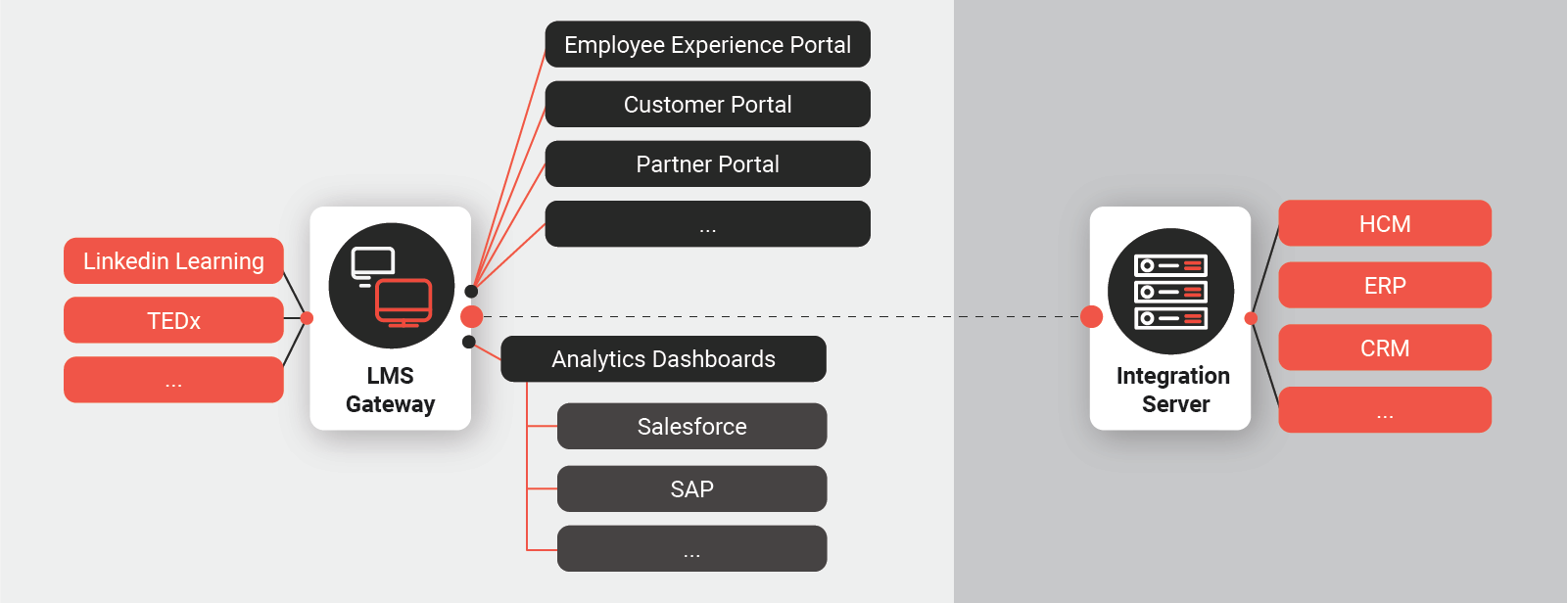
Next Generation Learning Technology
In Summary
If organisations look to unify both of their platforms, we can combine a user-centric approach with business outcomes to make learning success more visible. This will enable organisations to learn the “right thing” instead of just providing content or offering content for the sake of learning.
This blog is an excerpt of a published article by Sven Becker, a member of imc Board of Directors. The original article (German only) can be found here.

Gamified Learning to Drive Learner Motivation
Use gamified learning to increase employees' motivation and help them build their skills in the workforce.

Multi-tenancy LMS solutions
You can cover the needs of various internal and external learner groups with different training requirements by utilising the multi-tenancy LMS.
Contact


I just want to play!
Why gamified learning increases employee motivation
How can organisations incorporate gamified learning to build the skills of their employees? In our digital world, organisations are more likely to invest in e-learning but are often challenged by low completion rates. Therefore, content needs to be taught in a playful way! We checked with some experts how this can work especially in Australia.

Our play instinct
When it comes to the concept of play, we usually think about the interactions of children. A child’s imagination is not the limit of play. This is demonstrated by the Latin term “homo ludens” which means “the people playing”. Our play instinct is very pronounced, regardless of how old we are. This is because games offer us a world of fun and creativity. We mostly play in a digital context in the modern world, and institutions and companies alike can take advantage of this through gamified learning.
A recent government study of Australian higher education students² found that only 46.6% of online students completed their qualifications. For face-to-face students, this is 76.6% by comparison. These statistics are problematic, because if learners fail to gain knowledge, then both time and money are wasted. It is vital that we present e-learning content in a playful way.
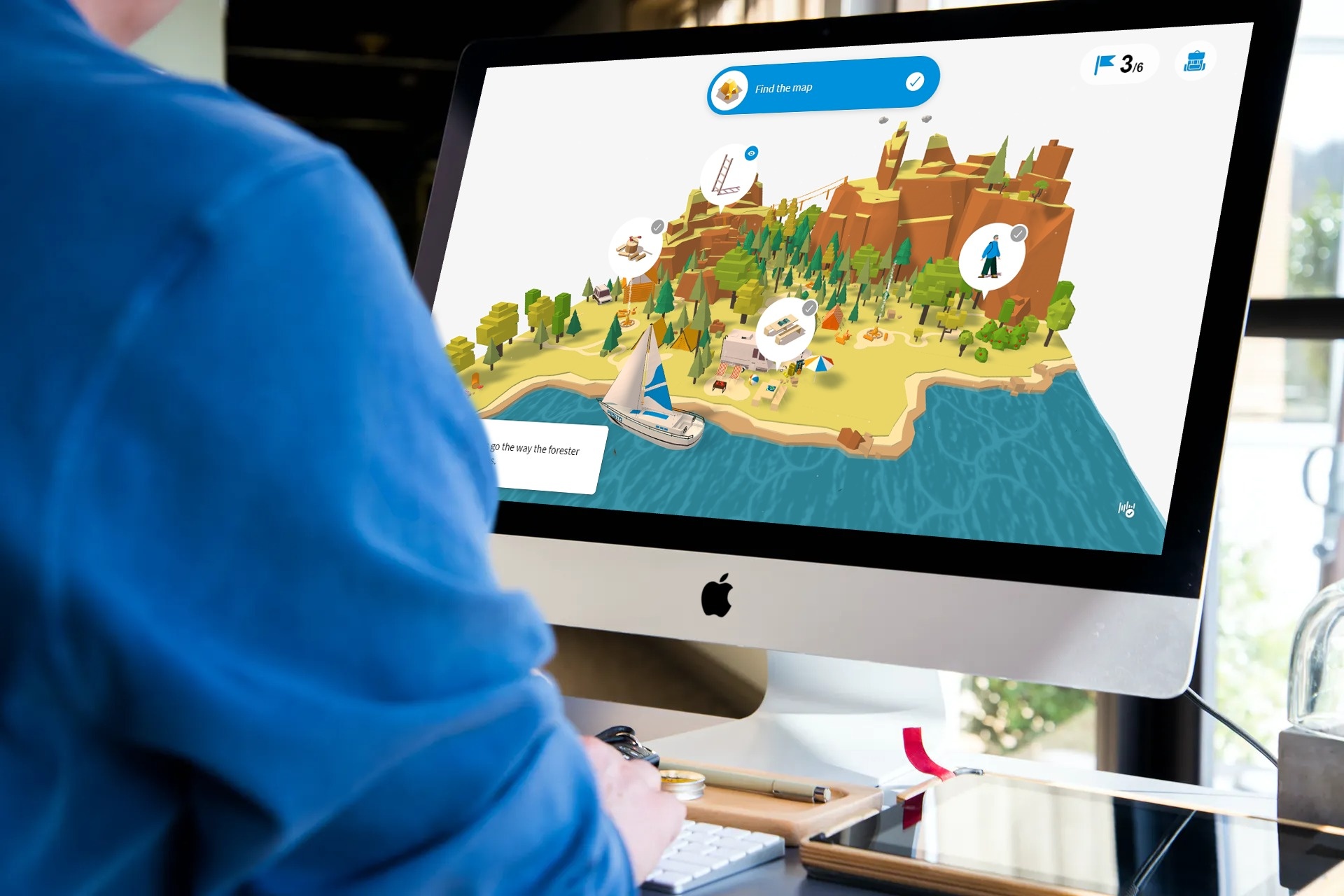
It’s time to get serious
Another sub-category of serious games is digital education games and gamified learning. Their primary focus is to impart knowledge. There are three types of serious games, these are:
Drill and practice games
The classic knowledge building games apps develop to build vocabulary or mathematic skills.
Quiz games
The BizQuiz app from imc is an example in which employees and entire teams can take part in engaging quizzes.
Point and click adventure games
Roleplaying games with enriched content and an exciting narrative.
The "City of Goods"

Learning through experience
The psychological benefit of gamified learning
Intrinsic
Extrinsic
Gamification is embedded in our everyday life. This can be through motivational tactics such as benchmarking (calorie or step counters) and nudging (such as point systems).
In summary, your employees are more likely to be motivated through gamified learning, when it is applied playfully.
Educational games can help reduce dropout rates and help employees build their skills in the workplace. Therefore: Game on!
This blog article is an extract from an article written by Sven R. Becker (A board member of imc AG) and Stephan Urbanski (Senior Instructional Designer at imc AG).
The original article was published in the I+MIO e-magazine (Available in German only).

Go for Game-based Learning
We talk about what lies beneath the trend of this playful knowledge transfer method. We explain why it works so well and present 3 application scenarios for game-based learning in the company.

Training soft skills with serious games
Softskills are more important than ever. But how to train them? imc's research team dealt with this challenge in the DEVELOP research project.
Contact

